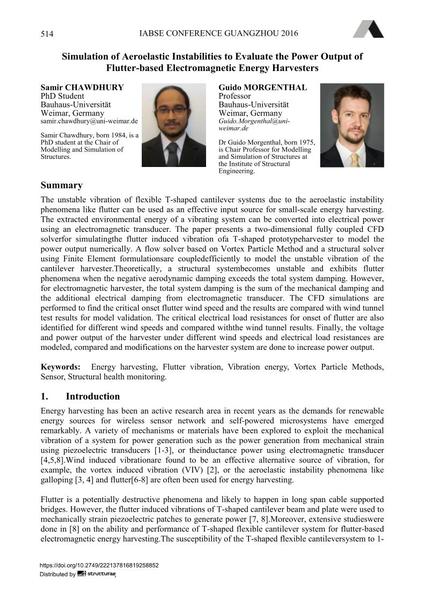Simulation of Aeroelastic Instabilities to Evaluate the Power Output of Flutter-based Electromagnetic Energy Harvesters

|
|
|||||||||||
Détails bibliographiques
| Auteur(s): |
Samir Chawdhury
Guido Morgenthal |
||||
|---|---|---|---|---|---|
| Médium: | papier de conférence | ||||
| Langue(s): | anglais | ||||
| Conférence: | IABSE Conference: Bridges and Structures Sustainability - Seeking Intelligent Solutions, Guangzhou, China, 8-11 May 2016 | ||||
| Publié dans: | IABSE Conference, Guangzhou, China, 8 – 11 May 2016 | ||||
|
|||||
| Page(s): | 514-521 | ||||
| Nombre total de pages (du PDF): | 8 | ||||
| Année: | 2016 | ||||
| DOI: | 10.2749/222137816819258852 | ||||
| Abstrait: |
The unstable vibration of flexible T-shaped cantilever systems due to the aeroelastic instability phenomena like flutter can be used as an effective input source for small-scale energy harvesting. The extracted environmental energy of a vibrating system can be converted into electrical power using an electromagnetic transducer. The paper presents a two-dimensional fully coupled CFD solverfor simulatingthe flutter induced vibration ofa T-shaped prototypeharvester to model the power output numerically. A flow solver based on Vortex Particle Method and a structural solver using Finite Element formulationsare coupledefficiently to model the unstable vibration of the cantilever harvester.Theoretically, a structural systembecomes unstable and exhibits flutter phenomena when the negative aerodynamic damping exceeds the total system damping. However, for electromagnetic harvester, the total system damping is the sum of the mechanical damping and the additional electrical damping from electromagnetic transducer. The CFD simulations are performed to find the critical onset flutter wind speed and the results are compared with wind tunnel test results for model validation. The critical electrical load resistances for onset of flutter are also identified for different wind speeds and compared withthe wind tunnel results. Finally, the voltage and power output of the harvester under different wind speeds and electrical load resistances are modeled, compared and modifications on the harvester system are done to increase power output. |
||||
